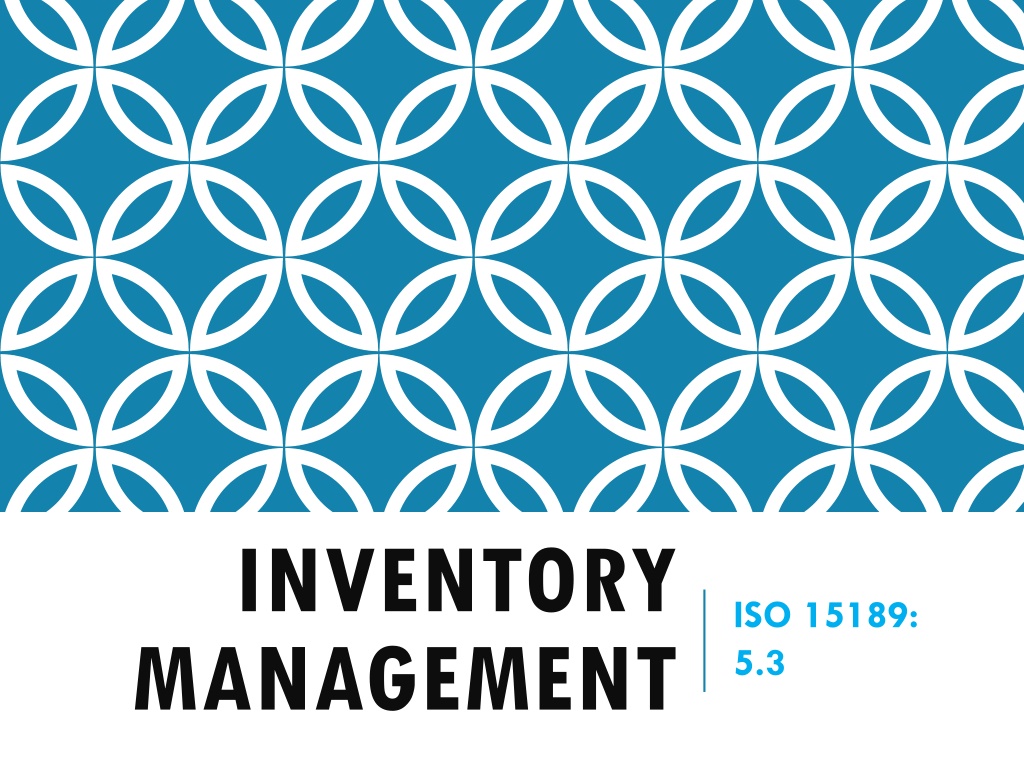INVENTORY MANAGEMENT.
Managing inventory under ISO 15189 guidelines involves Quantity, Quality, and Process management. Key aspects include demand forecasting, inventory movement control, consumption planning, and ensuring fitness for purpose. Quantity management aims to balance demand and supply, manage supply economics, and minimize response time while catering to variability. The objectives of inventory planning focus on maintaining supply continuity at an economic cost and minimizing material investments. Demand forecasting plays a crucial role in estimating future demand and influencing supply planning. Basic terms and terminology essential for effective inventory control are also covered. The process involves planning inventory and supply, estimating demand, placing purchase orders, receiving and inspecting materials, storing materials, and reviewing performance. Implementation of inventory control requires assigning responsibilities, maintaining inventory systems, analyzing needs, establishing receiving and storage systems, determining minimum stock needs, and developing necessary forms and logs.
Download Presentation

Please find below an Image/Link to download the presentation.
The content on the website is provided AS IS for your information and personal use only. It may not be sold, licensed, or shared on other websites without obtaining consent from the author. Download presentation by click this link. If you encounter any issues during the download, it is possible that the publisher has removed the file from their server.
E N D
Presentation Transcript
INVENTORY MANAGEMENT ISO 15189: 5.3
QUANTITY, QUALITY, PROCESS Quantity Management 1. Demand Forecasting & Planning 2. Inventory Movement Control 3. Consumption, Inventory and Operations Planning (CIOP) 4. Tools and techniques Quality Management 1. Ensuring Fitness for purpose 2. Acceptance testing Process Management 1. Receipt 2. Storage 3. Use 4. Safety 5. Discarding
QUANTITY MANAGEMENT Balance Demand and Supply Manage Supply Economics Minimize Response Time Why?? Cater to variability
OBJECTIVES OF INVENTORY PLANNING 1. Making available supply of materials in specified quantity and quality and maintaining the continuity of supply at the most economic cost- to Demand Forecasting & Planning 2. Minimizing the investment in materials and inventory carrying cost - Inventory Planning & Control
DEMAND FORECAST Demand Forecasting is estimating future demand of a product, material or service Factors that Influence Demand Demand forecast is used for: Planning of supply and ordering of materials Historical Demand Planning of resources e.g. equipment, manpower External Factors e.g. Weather, Epidemics Budgeting of costs Health Campaigns and Programs Planning of new tests/ services
BASIC TERMS & TERMINOLOGY Re-order when stock reaches minimum level Minimum stock - Amount of stock required to support testing operations until additional supplies are received Lead time Time between placing an order and receiving it Maximum usage number of test kits used in a given time period
PROCESS OF DEMAND, FORECASTING AND INVENTORY MANAGEMENT 2. Plan Inventory & Supply 3. Place Purchase Order 1. Estimate & Plan Demand 4. Receive and Inspect Material 6. Issue Material 5. Store Material 7. Review Performance
HOW TO IMPLEMENT INVENTORY CONTROL Assign responsibility Maintain inventory system in all storage areas Analyze needs INVENTORY CONTROL Establish system for receiving, storing Establish minimum stock needs Develop forms and logs
QUALITY OF MATERIALS IN LABORATORY: WHY TECHNICAL INPUTS ARE REQUIRED IN INVENTORY PLANNING Quality of Materials Performance Characteristics Operational Characteristics
PERFORMANCE CHARACTERISTICS Things to assess before purchase Precision Consequences of failing to do this pre-purchase evaluation Unacceptable Imprecision leading to uncontrollable CVs Accuracy Failing Proficiency tests Linearity (Analytical Range) False Negatives Analytical Sensitivity False Positives Analytical Specificity Biological Reference Interval
OPERATIONAL CHARACTERISTICS Consequences of failing to do this pre-purchase evaluation Things to assess before purchase Test complexity, Effort and training intensive method Turnaround time (TAT) Delayed reports Compatibility with current equipment/infrastructure/LIS Disturbed path of workflow, error Type and quantity of sample required Compromised patient care Patient/sample preparation required Pre-analytical acceptance criteria and possible errors Sample storage criteria Staffing/training requirements IQC/EQA requirements
PROCESS MANAGEMENT Activity Management Involvement Purchase of Materials or Services Supplier Evaluation Quantity Management Reception of Material - Storage of Material Acceptance Testing - Within Lab Inventory Management - Disposal of Unused And Expired Material Documentation -






















